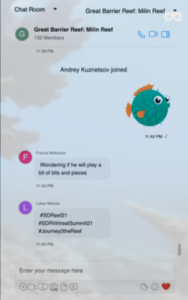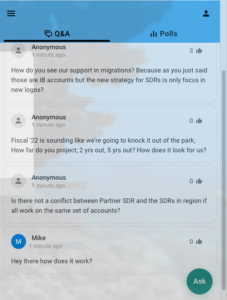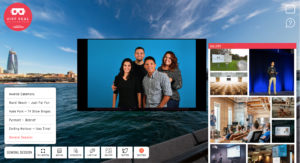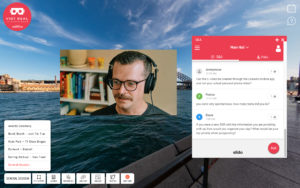Virt-Real Speakers Guide and FAQ’s
This is a guide for speaker/presenters using the Virt-Real virtual reality online event platform.
Top level overview:
Speakers use Zoom to present. All the usual Zoom features work and all the usual Zoom advice applies. We will get you to do a quick 10-15 minute run through/rehearsal a day or two before the conference to familiarise yourself with how everything works.
Note: There is a ~30 second delay between the live Zoom video and the audience livestream. If you are a conference attendee as well as a presenter, make sure you close the conference platform before switching to Zoom as a speaker, because that time delay will run the risk of confusing you, and possibly have you assuming you’re not “live” yet while your mic and video are being broadcast.
Timeline:
-
A day or two before the conference, we’ll take you on a quick 10-15 minute run-through to familiarise you with the platform and workflow, and the team you’ll be working with.
-
15 minutes before your session we’ll get you into a video chat “green room” to make sure you’re ready and comfortable with what you’re doing.
-
~2 minutes before your session time we’ll get you to join the Studio Zoom room. Assume your mic is hot and your video may be broadcast on the live stream.
-
There’s usually an MC with you in the Studio, who’ll introduce you in the livestream at your session start time. You may have an intro video or some intro music – please make sure we know about those if you want to use them.
-
You deliver your presentation, probably using screen sharing to show your slide deck.
-
At the end of your presentation there may be a Q&A session. The audience will have posted questions using the Q&A widget in the platform, and the MC or a Q&A moderator will join you in the studio and ask you and discuss those questions on behalf of the audience.
-
The livestream producer will let you know when the mics are cold and its safe to sneeze!
-
If there’s a follow on session after yours, we’ll probably hustle you out of the Studio Zoom room fairly promptly, to allow the next presenter to join and get set up.
General Zoom advice:
By this stage of 2021, pretty much everybody knows all this already, but let’s recap anyway.
Make sure you’re prepared your location for a broadcast Zoom session of the appropriate length. Take some care to minimise the chance of interruption. If needed and possible, have someone to mind the dogs or children while you’re presenting.
Make sure your background, lighting, camera angels, and audio setup are as good as you can get them. If you’re not sure, it’s good advice to do a practice Zoom call with a friend or colleague you trust to be gentle but critical, and who’ll tell you “you really should move that light” if needed, instead of “you look fabulous!” if you have hard shadows.
If you have co-presenters, make sure your lighting and backgrounds don’t clash badly. We’ll be overlaying speaker faces over the slide deck, so if there are two or three of you next to each other in the live stream, you probably don’t want to have vastly different light levels of background colours/textures. It’s worth getting that trusted friend from the previous paragraph to provide critical advice here.
Make sure you have your setup ready for screen sharing, and it is best practice to close all other open windows or documents.
Make sure you use the “Turn off any notifications” feature on your Mac or PC. You probably don’t want notifications of messages from your kids or notifications of an Amazon Prime delivery to show in the livestream!
If you are not screen sharing, and are a dynamic speaker who moves around on “stage” while talking, make sure your camera angles and field of view have been tested, and that you’ve suitably rehearsed staying within the camera’s view while you are moving around.
Another Zoom-related thing to consider is the non-greenscreen background blurring or replacement. This is not really “broadcast quality” and often doesn’t get it right and leaves strange artefacts especially around hair edges. This gets worse on lower spec laptops, since it’s reasonably processor expensive – the fans on my laptop always spin up when I’m using that because it has to work quite hard to do that trick. If speakers have lower spec laptops and do not have an actual greenscreen backdrop, the will probably get better video quality if they turn off background replacement (or blurring) and find a place with a suitable lighting and a flat coloured wall behind them to present from.
PS: Make sure you are not on mute…
Slide deck advice/requirements:
The livestream is a 16:9 aspect ratio, with a highest resolution of 1920×1080 “FullHD” if the user’s bandwidth supports it, but at lower resolutions on slow or congested networks, or for small screen devices.
-
Small screens and slow networks won’t get the FullHD resolution, so design slides knowing users may end up with 720p or even 480p resolution, or they may be watching on their phone’s small screen. Don’t use small text if it’s important that all of the audience can read it. A headline and 3-4 bullet points works better there than 3 or 4 paragraphs of text. Small text in images or on labels for charts may also be unreadable for some of the audience.
-
The live stream producer will overly your face, usually in the lower right corner. They can live-switch that to the top right corner or take out our for slides where that isn’t possible, but fir you can create your deck with the lower right 20% of the space free for your face, it’ll be least distracting for the audience.
-
Slide decks with embedded video and/or audio work in the platform, but if you’re going to use these make sure we get to trial them in the pre-conference run-through so we can check audio levels.
Details:
There is a Zoom room that we call the “Studio”.
You will be given the link to this room shortly before you’re scheduled to start presenting. Note that once you’re in the studio, you should assume your camera feed is live and your mic is hot, make sure you’re ready for that before joining the studio Zoom room.
Approximately 15 minutes before your scheduled time, we’ll meet you in a Google Meet video chat that we call the “Green Room”. There will be someone there to answer any last minute questions, and you’ll have a chance to prepare with any other people involved in your session such as any co-presenters, an MC who might be introducing you, and perhaps people to run your polls/quizzes and Q&A.
We use both Google Meet and Zoom, so you can have both open, and don’t have an awkward transition where you need to drop out of the Green Room before you enter the Studio. (In some cases where access to Google Meet is restricted by corporate policy, we might use an alternative video chat like Microsoft Teams for this).
Once you’re in the Zoom Studio, you’ll most commonly want to use screen sharing to present your slide deck. While you do this, the producer will overlay your face, usually in the bottom right corner. Keep that in mind when creating your slide deck. The producer can switch between bottom right and top right (or anywhere else) on the fly, or drop your face out if there’s a particularly dense full screen slide, but if possible keeping the lower right ~20% corner of your slides empty for the overlaid face makes for less distracting changes for the audience while you’re presenting.
Embedded video and audio in slides works, but make sure you let us know if you’re going to use these so we can check audio levels (ideally during your run through a day our two ahead of the conference). The livestream video the audience sees is 16:9 aspect ratio – at 1920x1080px for high bandwidth FullHD connections. Try to use a slide deck in that aspect ratio, otherwise it will get “letterboxed” with black bars at the sides or across the top and bottom to make it fit.
Available tools for use during your presentation:
There are a set of “widgets” in the conference interface that the audience can use. Live chat, Polls/Quizzes, Q&A, Resources, & Gallery. Some of these may be switched off on a per session basis by the conference organisers, ask them if you have a request to specifically enable or disable Live chat, Polls/Quizzes, or Q&A.
 Live chat
Live chat
This is a typical endless scrolling chat window available to all conference attendees. Depending on the organisers configuration it may allow anonymous posting, or may only allow posting under the attendee’s registered conference name. This can be switched off for individual sessions.
Polls/Quizzes
This is a widget that allows you to ask the audience questions with simple yes/no or multiple choice answers. It can be set show real time percentages of audience answers, or to wait until the presenter (or an assistant on their behalf) ends the poll/quiz and displays the answer/results. This can also be switched off if not required for the presentation.
 Question & Answer
Question & Answer
The Q&A widget allows the audience to post questions ask the presenter where it’s Q&A time (usually at the end of the presentation, but it can be used in the middle of a presentation too). The usual way this is used is that the MC or a Q&A moderator joins the speaker in the Studio (via Zoom) and asks the questions on behalf of the audience. This person can chose and prioritise which questions to ask, and if appropriate have a short discussion about out with the speaker. Note that often good questions get asked in live chat, so it’s good to have the Q&A moderator monitor that during the session and grab any goods questions from there that don’t get posted to the Q&A widget.
Resources
This is a place for the conference organiser admin staff to upload files. documents, PDFs, and slide decks. If you have resources like your slide deck you’d like to share, either before or after your presentation, let the conference organiser know and they’ll appear in here.
 Gallery
Gallery
This is a place for conference attendees to post pictures or videos. This is a global “whole of conference” widget, and is not configurable on a session by session basis. You (or more likely someone on your behalf) can post images in here during your session – this gets commonly used for things like stats, charts, or memes.

